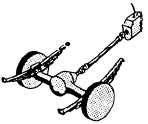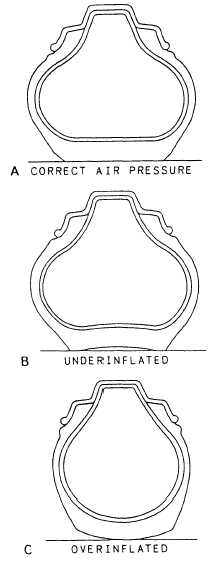FRONT AXLE SUSPENSION
Most passenger car front wheels are individually
supported with independent suspension systems. The
ones you are likely to see are the coil spring and the
torsion bar suspension systems used with independent
front axles and shock absorbers.
REAR AXLE SUSPENSION
Driving wheels are mounted on a live-driving axle
suspended by springs attached to the axle housing. Leaf
springs generally suspend live axles using the Hotchkiss
drive, as shown in figure 3-10. Coil springs are used on a
number of passenger cars with independent suspension.
TIRES
Because tires are expensive, they require proper
care and maintenance. While natural wear and tear
affects tire life, premature tire failure can be caused by
abuse and neglect. Proper maintenance of tires results
in better performance and longer service and prevents a
hazardous tire failure that can cause loss of life and
equipment.
TIRE INSPECTION
Tires are cut by sharp objects, bruised by bad roads
and stones, and injured by road shocks in general. To
drive with a seriously damaged tire is dangerous,
because it may blow out and cause the driver to lose
control of the vehicle.
Carefully inspect your vehicle tires during prestart
and post operations. Remove glass, nails, stones, and
other foreign materials embedded in tires. Tires give
longer mileage and safer driving when damages are
repaired immediately.
Inflation
Correct air pressure is the basis for reliable tire
performance. Tires are designed to operate at specified
air pressures for given loads and inflated to the
prescribed air pressure for your driving condition. When
Figure 3-10.—Hotchkiss drive.
checking air pressure, use an accurate gauge and check
the valve cores for leaks.
NOTE: Reduce the tire pressure when driving in
soft sand and over dunes. This increases the amount of
tire surface in contact with the sand to provide better
flotation (support). However, never reduce the tire
pressure so much that the tire slips on the rim. On some
equipment, the air pressure for normal conditions and
off-road conditions is listed on a data plate on the
dashboard or in the operator’s manual. When operating
with reduced tire pressure, drive at low speed. Inflate
the tires to normal pressure as soon as the situation
permits.
PROPERLY INFLATED.— A properly inflated
tire, as shown in figure 3-11, view A, shows proper
contact with the road.
Figure 3-11.—Proper and improper tire inflation.
3-7



